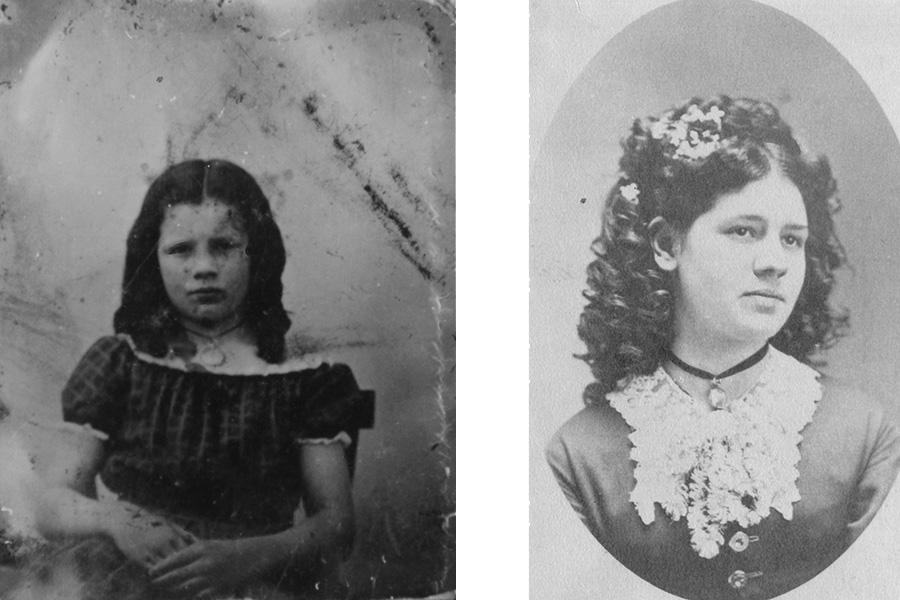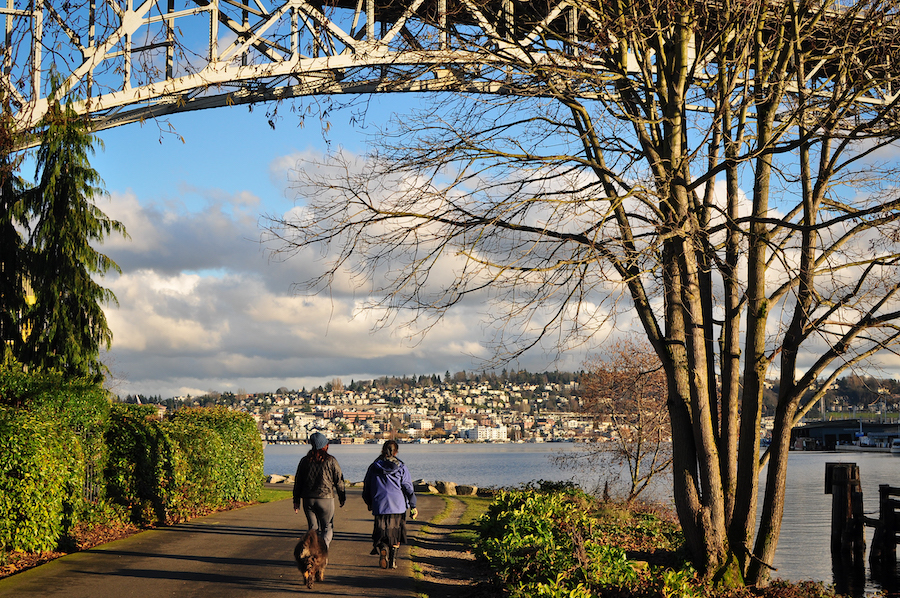First in Class: Washington Trailblazer Clara McCarty Wilt Was UW’s First Graduate

UW’s First Graduate Clara McCarty Wilt Was Also the First Woman in Washington State to Hold Public Office—40 Years Before Women’s Suffrage
In June 1876, the Territorial University of Washington—later the University of Washington—celebrated the conferral of its first degree, a Bachelor of Science diploma. Perched on a hill overlooking the village of Seattle, which had a population of 250 residents when the school opened in 1861, the college’s first 15 years had been touch-and-go; it had struggled with enrollment and funding, closed intermittently, and gotten by on sporadic donations from supporters like Henry Villard, president of the Northern Pacific Railway. To finally have a graduate to toast was a memorable occasion for both the school and the burgeoning city.
But today, the occasion is remembered for another reason: That graduate—the very first from the state’s flagship university—was a trailblazing female named Clara McCarty. McCarty, who came of age as Washington grew from remote territory to full-fledged U.S. state, would also go on to be the first woman elected to public office there.
Ruth and Jonathan’s Daughter
McCarty’s parents, Jonathan Warren McCarty and Ruth Jane Kincaid, arrived in Washington via the Oregon Trail—their families among the very first settlers in the territory. According to Deb Freedman, author of “Leading Ladies: Twenty-One of Tacoma’s Women of Destiny,” Jonathan and Ruth were the first documented couple to be married in Pierce County,” just two years after Congress authorized the creation of the Washington Territory.
The newlyweds settled in Sumner, a small settlement about 12 miles southeast of Tacoma. Freedman says that in those days, Sumner was likely a pretty austere place. “It would have maybe had a bank or two, maybe a school, and just a few of those early, early settlers.” The McCartys owned and operated a farm that grew hay and hops.
When the Treaty Wars—an uprising by Indigenous tribes in the territory in response to violence and displacement by white settlers—broke out, the McCartys sought safety at nearby Fort Steilacoom, where Clara was born in 1858.
“It was a pretty incredible start to a childhood,” said Freedman, “born into a place where your family is physically hiding.” (As it turns out, Steilacoom was the perfect place for a woman of many firsts to be born, being the first incorporated community in the territory and boasting its first school district, public library and jail.)
When the family returned to their farm, they found their livestock gone, and their barn and home burnt to the ground. The McCartys rebuilt, and Clara spent the first 12 years of her life on the banks of the Stuck River, where Mount Rainier loomed snowy on the horizon. Not much is known about Clara’s upbringing among her four brothers and sisters, but photos of her from this time show a serious child with thick, brunette curls and dark eyes.
In 1870, as construction began on the Northern Pacific Railway—the last of the transcontinental railroads and the first to reach Washington—the McCarty family moved to Seattle.
“There were lots of reasons to move to Seattle,” Freedman said. “Especially when you had young daughters looking for someone to marry.” The McCartys, however, seemed most interested in getting their children, including the girls, a good education.
First in Class

After a few years in a Seattle school and three more of college preparatory work, Clara McCarty entered the Territorial University of Washington. The university had been founded by early territory leaders eager to make Seattle a prosperous town that could compete with other West Coast cities.
Freedman described it as an ambitious gambit. “It was the legislature that said, ‘We’re going to be big, we’re going to have a university,’” but from the outset, the school struggled, largely due to a lack of students. “There just really weren’t many students in the entire territory who had an education equivalent to a high school diploma,” she explained. For a time, the only enrolled student was the son of a university founder.
In fact, for years, the majority of the college’s students were actually primary- and secondary-school-aged children from Seattle. “The so-called university was really little more than a 19th-century daycare center and a one-room schoolhouse,” according to historian Feliks Banel of Seattle public radio station KUOW.
By the time McCarty arrived, though, the population of Seattle had swelled into the thousands and her freshman class boasted a healthy 17 students.
At the school, McCarty enjoyed one-on-one attention from her teachers. Instruction wasn’t given in formal lectures, but in wide-ranging class discussions. In later years, she described those scrappy days to a reporter: “There were less than 100 students with eight members of the faculty. About 30 students lived at home in Seattle. The 16-room dormitory housed both men and women. Tuition was $30 a year, and books were shipped from around the Horn from the east,” she said. “Typewriters and fountain pens were unknown, and even notebooks and pen and ink were scarce. Nearly all writing was done with pencil on foolscap paper.”
Despite starting her college career with 16 classmates, McCarty was the only one to earn her degree, becoming the university’s very first alumna in the spring of 1876. On the 50th anniversary of her graduation, she told the Seattle Daily Times that as the only graduate, she had “shared honors as class president and valedictorian.”
While the graduation signaled the end of her collegiate days, McCarty’s relationship with her alma mater would remain strong. In 1936, during the 75th anniversary celebration for the college—by then known as the University of Washington and located northeast of Seattle— McCarty’s family set up a scholarship in her name: a $50 stipend for the “most leading student in science.”
In 1962, the university named a residence hall after her.
Clara McCarty Wilt and the Burke-Gilman Trail

A host trail of the developing 3,700-mile Great American Rail-Trail®, the Burke-Gilman Trail stretches 20 miles from Shilshole Bay in Seattle to the city of Bothell, where it dead-ends into the Sammamish River Trail. Built in the 1970s, it was one of the nation’s first rail-trails. Once a segment of the Northern Pacific Railway, today the trail is a busy thoroughfare for weekday commuters. On the weekends, the paved Burke-Gilman Trail (besides a 1-mile on-road portion in the waterfront neighborhood of Ballard) is usually teaming with joggers, skaters, strollers and tourists, as it offers access to Seattle’s vibrant neighborhoods, waterfront views and leafy parks.
About 7 miles from the eastern terminus, trail users will arrive at the University of Washington and the lively U District, full of cafés, art galleries and museums. McCarty Residence Hall—named after Clara McCarty Wilt, the university’s first graduate—is located near the trail’s underpass at NE 45th Street. The dorm opened in 2018, after the original McCarty Hall, built in 1962, was torn down.
Politics and Prose

In 1877, McCarty moved to Oakland, California, for graduate school at the University of California, an accomplishment, Freedman said, “that was so, so unusual for a woman of that time.” After earning a master’s degree in education, she returned to Washington and taught in a number of public schools in and around Tacoma.
As the number of settlers in Washington surged—fueled by increasing numbers of people heading west—the public school system was badly in need of leadership. In 1880, with an impressive academic pedigree and years of schooling under her belt, McCarty threw her hat in the ring for the newly created position of Pierce County superintendent of schools—and won.
Clara McCarty was the first woman to hold public office in Washington Territory, elected three years before women in the territory got the right to vote and 40 years before women’s suffrage was granted on the federal level. According to one Tacoma historian, McCarty achieved this at a time when “there was much opposition to women in politics. They were dubbed ‘pantaloonatics.’”
As the superintendent of schools, McCarty oversaw 25 schools throughout the county. One was in Wollochet Bay, the first school on the Olympic Peninsula. For her twice-yearly visits there, McCarty chartered a small steamboat.
In 1882, McCarty married John Wilt, a fellow school teacher who would go on to become a clerk of the United States Courts. Though she opted not to seek re-election—choosing instead to be a wife and mother— McCarty Wilt had clearly blazed a trail: Her own successor was a woman.
Clara and John had one child, a daughter named Clara May Wilt, and settled in Tacoma, where Clara stayed active in civic and religious organizations. But in 1907, when John died, Clara went back to work.
“Again, it was an unusual thing, this single mother working,” said Freedman. “She was a secretary at the YWCA, which was [considered at that time] an acceptable job for a woman. And then she was an assistant to William Bonney, a prominent local historian, at the Washington State Historical Society.”
Freedman argued that it was McCarty Wilt’s job with Bonney that ensured her life story was so well documented. Most women’s experiences from this time—no matter how singular—would have been lost to history. Even still, Freedman said that beyond the McCarty name being emblazoned on a UW dorm, “the vast majority of people in Washington have probably never heard of her.”
During her life, most Tacomans didn’t know Clara McCarty Wilt as the first graduate of UW or first woman to hold elected office in the state, but as the person who owned the county’s first typewriter.
In 1883, as the last spikes were driven into the Northern Pacific Railway, another world-changing technology arrived in the Pacific Northwest. McCarty Wilt answered the door to many neighbors who wished to see this newfangled typewriter, and, between visitors, typed up legal briefs for a local law firm, according to Freedman. She made about $10 a day doing so—an unusual amount of money for a woman, or anyone, at the time.
Clara McCarty Wilt died in 1929 at the age of 71. She’s buried in Sumner, not far from the land that her parents once farmed.
This article was created by Rails to Trails magazine as part of History Along the Great American Rail-Trail®, a project of TrailLink™ highlighting hundreds of stories and historical points of interest along the 3,700-mile route.
Related Blogs:
- End of the Line: How Timber and Train Tracks Transformed the Olympic Peninsula
- Remembering the Chinese Forerunners Who Built the Northern Pacific
- Industrial Heartland History: Scott’s Run—the Most Diverse Coal Camp in America
Read more great history stories on the TrailBlog.

Donate
Everyone deserves access to safe ways to walk, bike, and be active outdoors.
